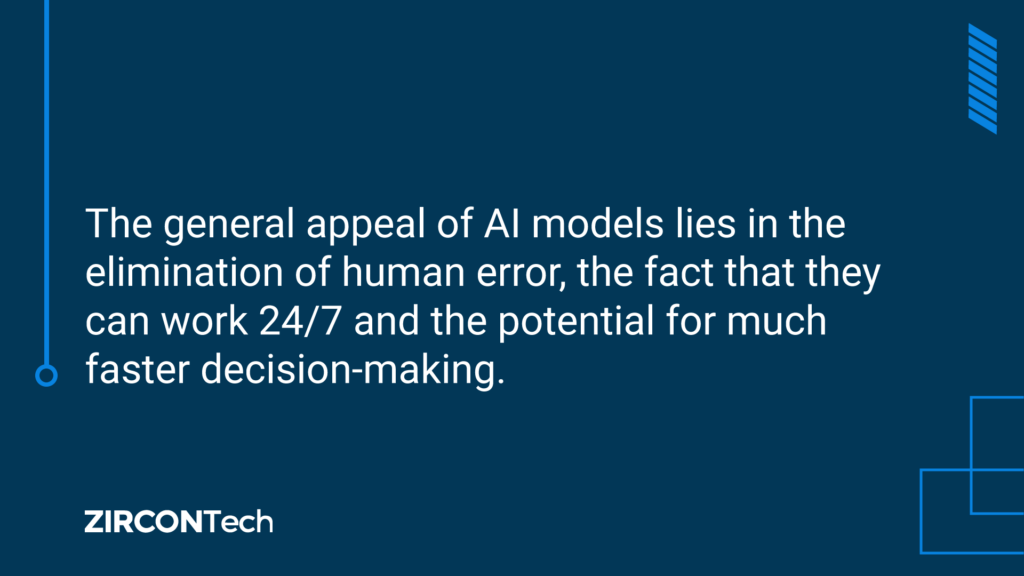Artificial Intelligence Software Development Company
AI Programming At The Heart Of Future Commercial Innovation
Artificial Intelligence (AI) is one of the most fascinating areas in the world of technology today. Advances in AI programming are moving at an astonishing pace as innovations that were once strictly confined to the realm of science fiction play an increasingly prominent role in the operation of modern businesses.
As an end-to-end provider of software development, ZirconTech is fully aware of the potential of artificial intelligence programming to boost commercial performance.
Our certified experts work with customers to explore AI initiatives and machine learning projects that ensure the attraction and retention of new clients and enhance their revenue and profitability.

Why Artificial Intelligence is Playing a Key Role Today
On average, it takes eight months to integrate AI models fully. However, this is an essential consideration regardless of the complexity involved.
How AI Programming Will Evolve in the Next Few Years
Investment in AI initiatives is set to continue its upward trajectory. A majority of CIOs will be focusing on AI and distributed cloud technology, according to a survey in late 2021. As the sector continues to mature rapidly, it is predicted that by 2025, 70% of organizations will have operationalized AI architectures. By then, a similar proportion will be focusing on small and wide data, rather than big data, to deliver a more three-dimensional approach to their analytics. It is also estimated that by 2025, more than 30% of new drugs will be discovered using AI techniques. If organizations want to use generative AI, synthetic data and orchestration platforms, it is essential that they begin to lay the groundwork as soon as possible. In the next few years, certain AI capabilities will move from their current concept status to delivery, further enhancing the desirability of AI programming. These include:
In the next few years, certain AI capabilities will move from their current concept status to delivery, further enhancing the desirability of AI programming.
These include:
Composite AI: The combination of various techniques will improve efficiency.
AI orchestration and automation platform: This technology will standardize deployment pipelines and unify development, delivery and operational activities.
AI governance: Frameworks for the management of risk in AI programming and implementation are being developed.
Generative AI: The ability to create new content is still emerging but it is expected to be adopted rapidly.
Human-centered AI: Also known as human-in-the-loop, this approach involves a close relationship where some tasks are completed by an algorithm and others by people.
Synthetic data: Artificially generated data is cheaper and faster – but it can have bias issues.
Working with ZirconTech to Integrate AI in Your Applications
60% of CIOs across sectors expect to adopt blockchain in the next three years. Start your blockchain development project now to stay ahead of the competition! Blockchain is the distribuited ledger technology that is being used to facilitate direct value exchange over the internet. It is fast becoming the system of choice for business transactions thanks to its great benefits that speak for themselves.
According to Gartner, “We expect blockchain smart contracts to increase overall data quality by about 50% by the year 2023. Better data availability will, in turn, improve the decision-making process for organizations. Hence it recommends blockchain for data and analytics (D&A).
When an organization adopts blockchain smart contracts -whether externally imposed or voluntarily adopted- they benefit from the associated increase in data quality.

Working with ZirconTech to Integrate AI in Your Applications
ZirconTech has extensive expertise in AI programming languages, which makes us an ideal partner in the development, deployment and successful application of AI solutions. Our teams can integrate smoothly and work closely alongside your people to deliver your most valuable features.
Most challenges in the deployment of AI programming solutions have their roots in low-quality data, insufficient resources and internal misalignment. With the assistance of a partner with considerable experience, these issues can be identified and mitigated.
or email us to learn more about our expertise and knowledge in this field and our ability to implement capabilities that make a substantial difference to your commercial operations.